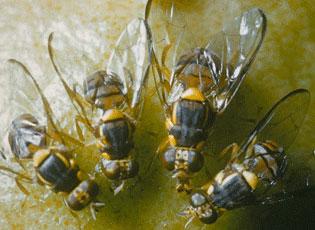Bactrocera dorsalis (Hendel, 1912) (ITIS)
Oriental fruit fly (OFF)
First recorded in Taiwan (Shi et al. 2005)
Introduced to Hawaii in the 1940s; several infestations in the continental U.S. have been discovered since then, triggering eradication programs (Weems and Heppner 2016)
Possibly introduced to Hawaii by U.S. military troops returning after World War II (Weems and Heppner 2016)
Destructive pest of fruits and vegetables (Weems and Heppner 2016)

Oriental Fruit Fly, Adults Florida Department of Agriculture and Consumer Services, Division of Plant Industry
Spotlights
Distribution / Maps / Survey Status
Federally Regulated
All Resources
Selected Resources
The section below contains highly relevant resources for this species, organized by source.
Partnership
Federal Government
International Government
State and Local Government
Integrated Taxonomic Information System. Bactrocera dorsalis. [Accessed Sep 21, 2023].
Shi, W., C. Kerdelhue, and H. Ye. 2005. Population genetics of the Oriental fruit fly, Bactrocera dorsalis (Diptera: Tephritidae), in Yunnan (China) based on mitochondrial DNA sequences. Environmental Entomology 34(4):977-983.
Weems, H.V., J.B. Heppner, J.L. Nation, and G.J. Steck. 2016. Oriental Fruit Fly, Bactrocera dorsalis. University of Florida, University of Florida, Institute of Food and Agricultural Sciences Extension. Electronic Data Information Source Publication #ENY083 (IN240).
